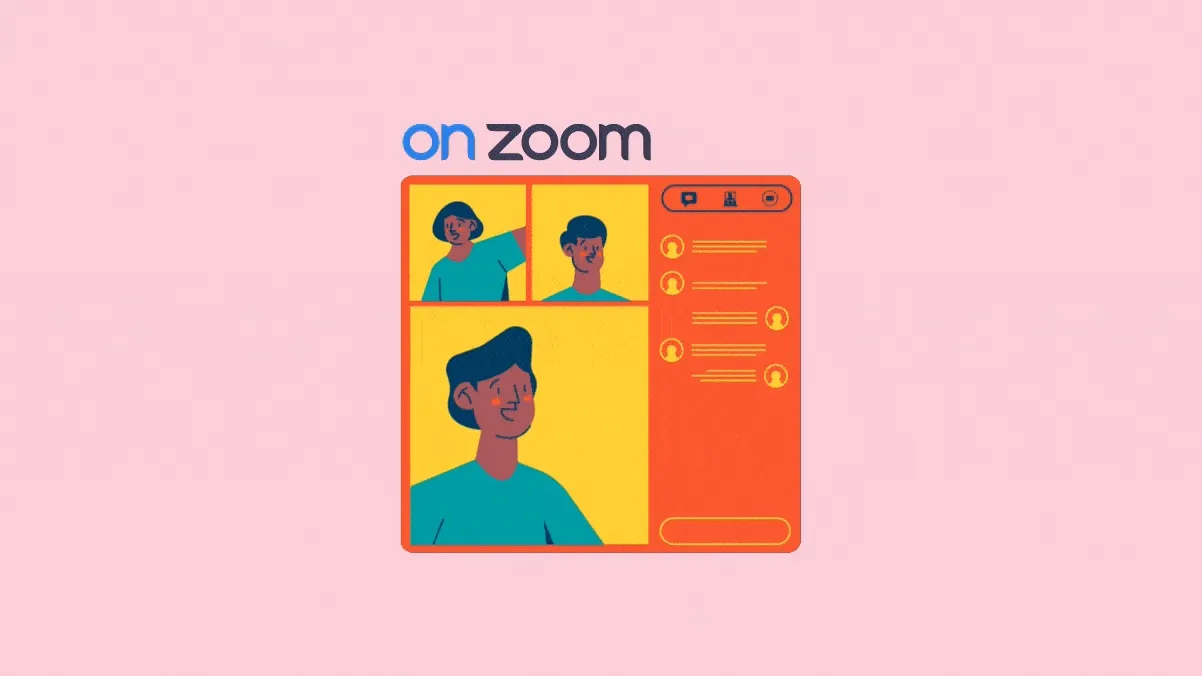The pandemic has completely changed the way we do things. We’re not just having meetings or classes for school online anymore. It’s everything now – attending concerts, comic cons, yoga classes, cooking classes, workout sessions – you get the gist. Anything you need to do, you can do it online. And Zoom has been one of the forerunners in this category.
But the current Zoom meetings platform was designed for hosting meetings, not online events. And even though we have been making do, it’s not the same thing. All that is going to change now.
Zoom announced OnZoom at Zoomtopia this year, the annual Zoom User Conference that, too, was held online this year. OnZoom is an extension of Zoom’s unified communications platform. Using OnZoom, licensed users will be able to create, host, and even monetize online events using the same platform as Zoom Meetings. Attendees can participate in events with any type of account.
What is OnZoom?
OnZoom is an event engagement platform solely for the purpose of hosting online events. The beta version for OnZoom is now available for use in the US for all licensed Zoom users at no extra cost. Whether you are a business owner, a musician, dance, or ceramics teacher, you can use the OnZoom platform to host events/ classes.
Users can host events for from 100 to up to 1000 participants (depending on their Zoom account) and even monetize them easily. The entry to the event can be free, with a paid ticket, or a hybrid of both. And the payment system is completely secure and simplified. Attendees can pay for tickets using PayPal and major credit and debit cards.
Hosts can only accept money for tickets using a PayPal Business account. If you don’t have one, create it from PayPal’s website. It usually takes a couple of days for your PayPal Business account to get up and running.
If you need to include more participants in the event than the allotted limit, you can also turn it into a live streaming session.
Attendees can go to on.zoom.us and discover and track the events or classes that interest them. The full directory of upcoming public events will be available to discover and browse at your fingertips.
Getting OnZoom Host Access
Only owners or admins of a paid Zoom account can use OnZoom. But before you can start using OnZoom beta, you need to apply to become a host. Click here to go to the application for OnZoom beta.
Filling the application doesn’t guarantee host access. OnZoom’s team will review your application and decide whether to provide you with Host access. OnZoom beta is only available in the United States right now, so only users with a US-based Pro, Business, Enterprise, or Education Zoom account can host events currently.
Fill up the questionnaire for the application form that includes basic details about your account like your name, email address, Zoom account number, whether your organization is tax-exempt, etc.
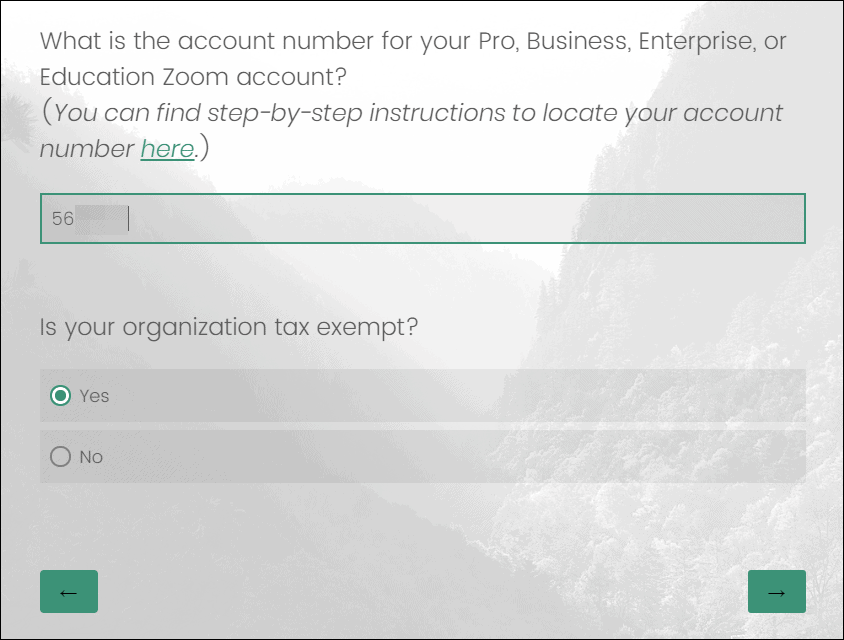
Then comes the question about why you want to use OnZoom. Make the part about why you want to use OnZoom as clear as possible, as the approval of your application will depend on it. Submit your application after completing it.
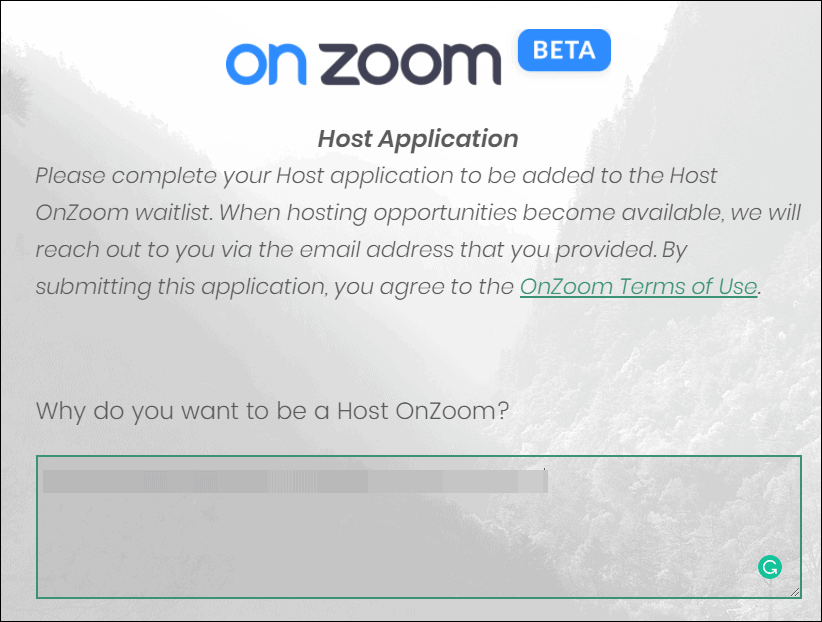
Zoom’s team will respond with an email to let you know whether your application was approved or added to a waitlist for future re-evaluation.
You can also be asked to re-submit your application without it being either rejected, waitlisted, or accepted. Keep an eye on your emails, and re-submit your application if that happens. Otherwise, your application status wouldn’t move forward.
If your application is accepted, you’d first have to attend a mandatory training session with the OnZoom team. You’ll receive an email with a few upcoming sessions you can attend. Click on the link for the one that suits you, and register for it. These links will only work for you, and you can’t share them with anyone else. The training session will also include an FAQ where you or other attendees present can ask any questions about the OnZoom host experience.
Once you attend the mandatory training session, you will get host access. It might take some days after the training session for you to receive the approval email, but it’ll happen.
Creating and Hosting Events on OnZoom
Once you have host access, you can start hosting events on OnZoom. Go to on.zoom.us and login with your host account.
Before the host access, your OnZoom home page will only be a place where you can discover published events and register for them. But after you have access, a few options will appear on the top right corner of the screen, next to your profile icon.
Setting Up Your Host Account
Click on the ‘Create’ button to create an event.
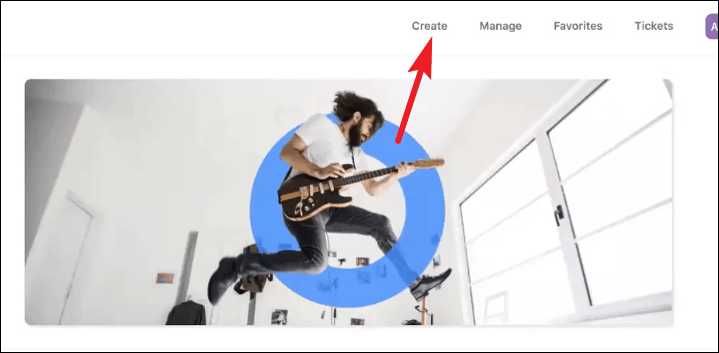
The first time you go to create an event, you’ll reach the community guidelines page. Scroll through the page and read them, then mark the box for ‘I have read and accept the Community Standards’ and click the ‘Accept’ button to move forward.
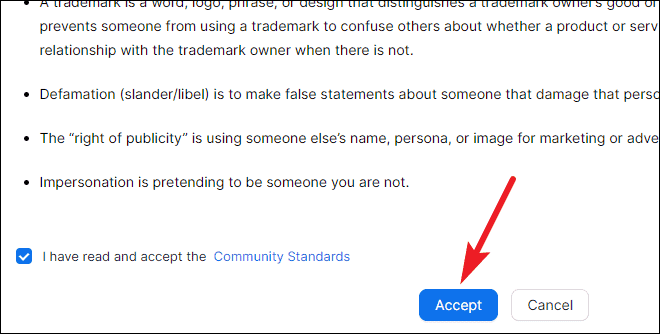
Then, before you can create an event, you’d need to complete the initial setup for your account. The first step includes your host profile. Your Host profile is the information about you that you want to make public for potential attendees. It’s visible with each event and plays a part in letting attendees decide whether they want to attend your event. It includes putting up a profile picture and a short description of yourself. You can edit these later.
On the next page, link your PayPal Business account. This step is optional, and you can skip it if you want to host only free events. But to host paid events, you need to complete this step. Currently, a PayPal Business account is the only way you can charge for tickets.
Also, if you want attendees to be able to pay for tickets with credit and debit cards, enable the option for ‘Accept your credit card payments with PayPal’. If you skip this now and want to enable it later, you’ll have to delink and then link your PayPal account again to change this option setting.
Then, on the next page, enter your Billing address. This is, again, optional, and you can skip it if you want to host only free events. But to host paid events, this is a necessity. You can also submit your tax-exemption information here if your organization qualifies for tax exemption.
Finally, click ‘Save’. The initial setup for your host account is complete now.
Creating your First Event
Once you’ve set up your account, you’ll reach the page where you can create the event. Event creation consists of three steps: Event Card, Event Profile, and Tickets.
The first step is the Event Card. You have to provide a name and a short description of the event in less than 140 characters.
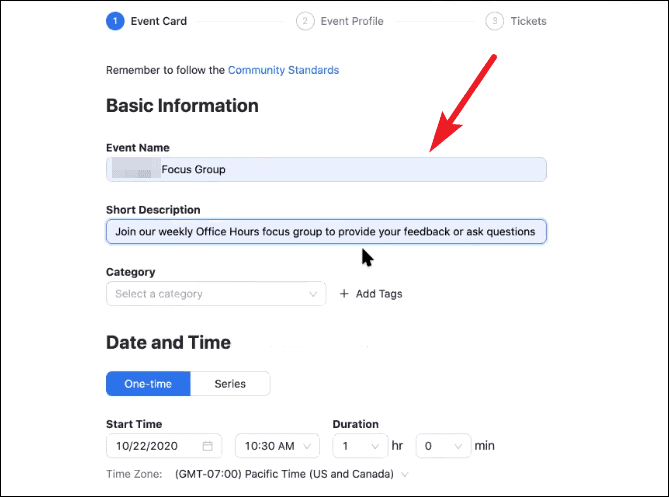
Then, select the category of the event, and you can also add tags to provide additional information for tracking them. You can add up to 8 tags.

The next part is setting the date and time for the event. The event can be One-Time, or it could be a series. For a One-Time event, you need to specify the start time and the duration.
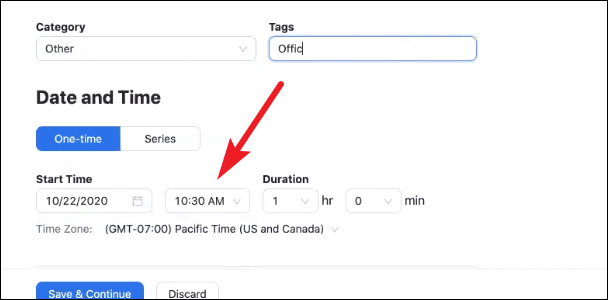
Click on the ‘Series’ option to switch to a series type event. For a series-type event, along with the start time and duration, you also have to mention the frequency of recurrence, and the number of events after which you want to series to end, or the date on which it should end. The time and duration of all the events in the series will remain the same.

Along with free or paid events, OnZoom will also be adding the functionality to make the event a fundraiser. The feature has started rolling out, and when it reaches your account, you’ll be able to turn the toggle on for ‘Fundraiser’ and add a Non-Profit organization for which you want to raise funds.
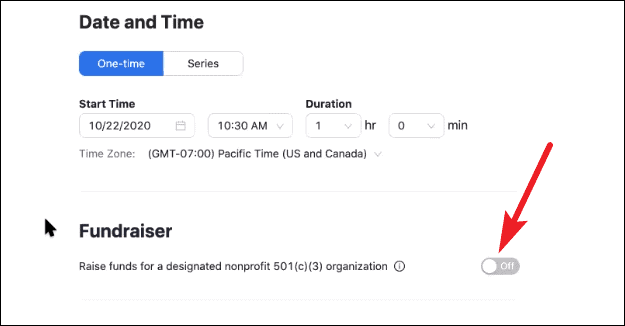
Then, there are ‘Event Options’. You can configure the Joining Settings, Event Security, and options for Cloud Recordings and Live Streaming. Click on them to expand further options.
Under ‘Joining Settings’, you can decide whether you want to enter the event with the video on, whether there’ll be a waiting room for the event, and if attendees can join 5 minutes ahead of time.
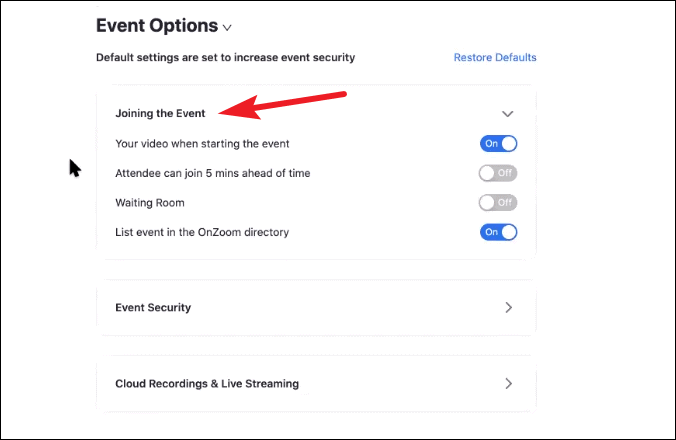
One of the interesting options here is whether you want to list your event in the Zoom directory. By default, the toggle for this option is on. When it’s in, your event will be publicly discoverable on OnZoom. It’s important that you have this toggle on to maximize the reachability of your event. But if you want to have a private event, that you can only share with a link, turn it off.
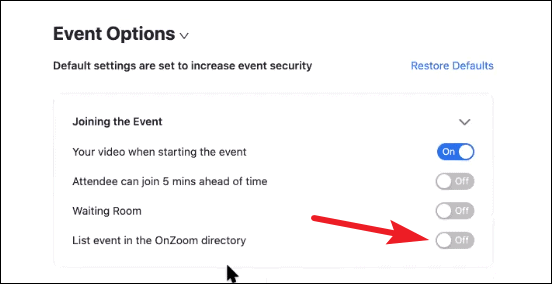
The second customizable option is for event security. When you click it, the following options will expand: ‘Attendees can send 1:1 chat messages’, ‘Attendees can change screen names’, and ‘Attendees can share their screens’. By default, all these options are off to maximize security. You can turn them on, but OnZoom suggests to proceed with caution and only turn them on when you can trust the attendees and know they won’t disrupt the event.
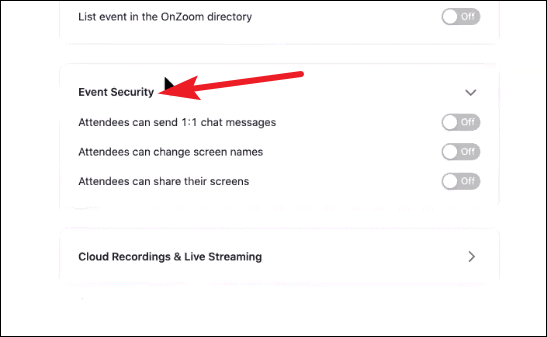
The last option is for Live Streaming and Cloud Recording. By default, recording for events is off.
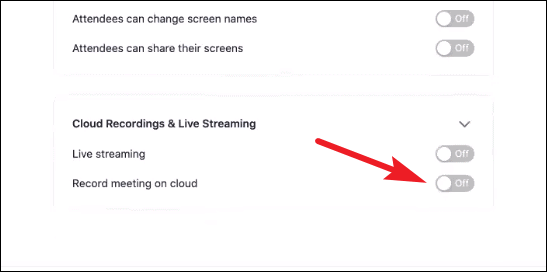
If you turn Cloud Recording on, you’ll get a disclaimer saying that “turning on this feature [cloud recording] requires attendees to agree to be recorded and may affect ticket sales”. You’ll have to confirm that you want to enable it by clicking the ‘Enable’ button. If you enable cloud recording, your event information page and the purchase flow for tickets will consist of an additional message for potential attendees that “the event may be recorded”.

After configuring all the settings, click the ‘Save & Continue’ button to proceed to the next step.
The next step is the Event Profile. It includes setting photos for the event, adding a YouTube link, and further information about the event attendees need to know. Your event must have at least one cover photo, but you can add up to three event photos.
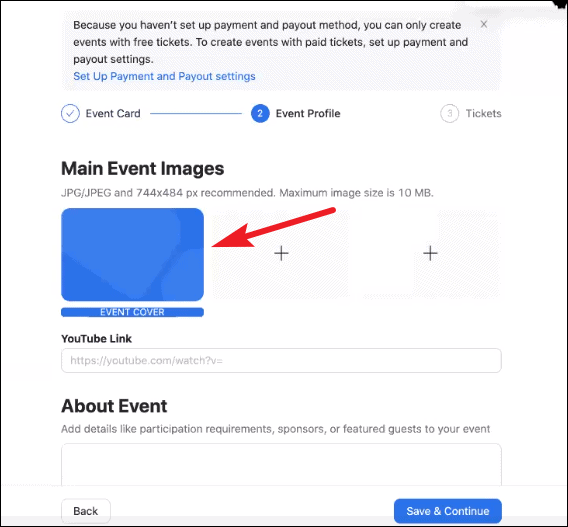
You can also add a YouTube link that contains information about the event. The YouTube video appears as an additional thumbnail next to the event images.
The last option on this page is the contact info. You cannot change the contact email, as only the account with host access can be contacted by attendees. But you can change the contact name.

Click on ‘Save & Continue’ to proceed to the last step.
The final step in creating your event is ‘Tickets’. Arguably, also the most important part of the event you’re creating. You can have free or paid tickets for your event or a hybrid of both. But if you don’t have the payment method set up, you can only have free tickets.
The first thing you’ll see on the Ticket page while creating your event is the event capacity. The number of attendees depends on your account type, and you can upgrade your account from this page easily if you want.
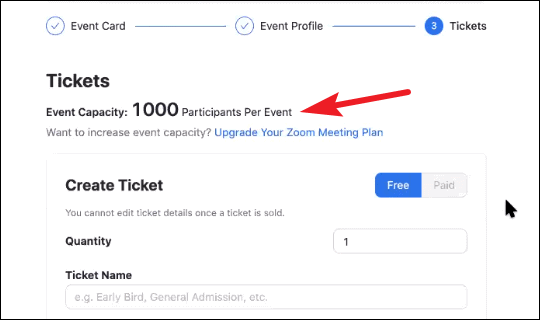
Then, select your ticket type by selecting either ‘Free’ or ‘Paid’ from the options.
You can different types of tickets for a single event. So, for example, if you want to have cheaper tickets for early birds, and pricier tickets for General admission, or free tickets for people from a certain domain, you can create different ticket types for these.
To create a ticket, enter the quantity for that type of ticket you want to sell. The total number of tickets for your event depends on your account. So, if you have an account that supports up to 1000 attendees, you can have a total of 999 tickets.
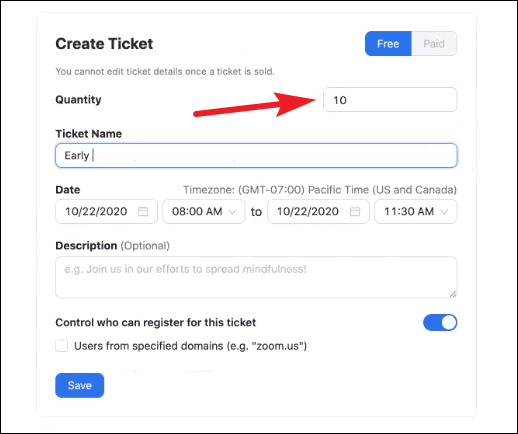
Then, enter the name for the ticket. Eg. Early Bird.
If it is a free event, the ticket will be free. For a paid event, the ticket can be anything from $1 to whatever you want. There is an upper cap for the ticket price, but OnZoom says it is quite high, and rather unlikely you’ll try to price your ticket at that value. So, you don’t have to worry about the maximum price you can decide on the ticket.
Then, enter the date and time range during which the ticket will be available for sale. If you want attendees to be able to buy tickets even during the event, you can time the sale of ticket accordingly.
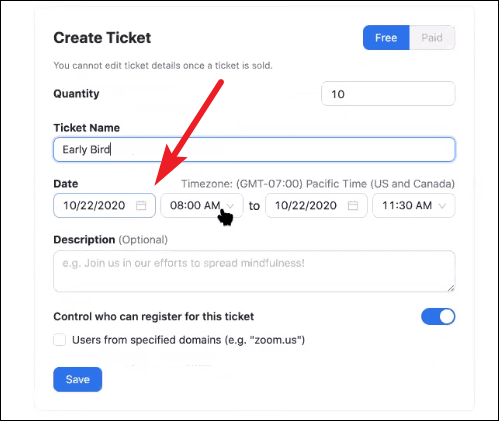
If you want to make the ticket available to only certain people, for example, those who register with a particular domain, turn on the toggle for ‘Control who can register for this ticket’. Soon, you’ll also be able to make it available to only people invited by email. Then, select the checkbox for ‘Users from specified domains’ and enter the domain name.
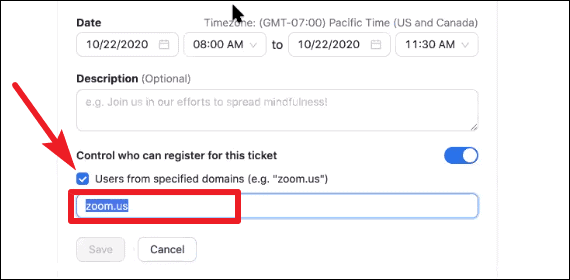
Finally, click ‘Save’.

To add another ticket type, click on ‘Add Ticket’ and repeat the process and add multiple tickets for the event.
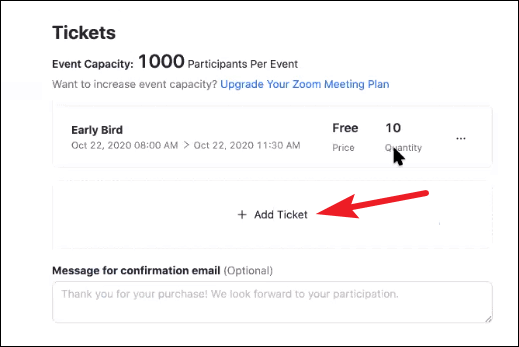
For a series event, only two types of tickets are allowed currently. One is for the entire event series and the other a drop-in ticket that can be purchased for a single event in the series.
Then, before clicking the ‘Publish’ button, OnZoom advises going through your event details once again. Once you’re sure, click the ‘Publish’ button, and your event will be created. If you don’t want to publish it right away, click the ‘Save’ button, and you’ll be able to revisit the draft at any time.
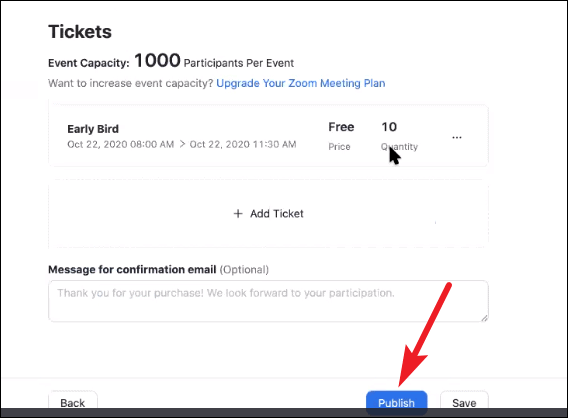
Only people with a ticket can attend the event. Even if they share the link they receive with others, they can’t attend the event unless they register for it and buy a ticket. If an attendee creates trouble, you can also remove them from the event.
The cancellation policy for your events is decided by you. If you do decide to have a cancellation policy, you’d have to incur a slight loss as PayPal’s transaction fee is not refunded. But OnZoom suggests having a cancellation policy as it can affect your host rating. And a good rating matters on OnZoom.
OnZoom is a great place to have events for your business, but before hosting an event, it is important to acquaint yourself with the platform and its best practices. It’s part of the reason OnZoom hosts mandatory training sessions before granting host access. As it is not a meeting with people you know, it is paramount to maintain security. For that, you need to know the workings of the platform intricately. But once you know the platform a little better, you can host all the events you want.

